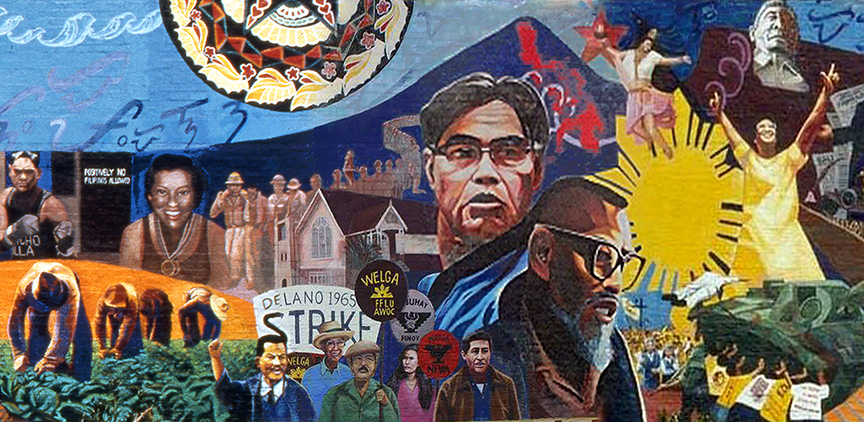There is a good chance that you have heard the story of Latino farm labor leader and civil rights activist Cesar Chavez and his role in the Delano Grape Strike in California’s Central Valley. In 2014, President Barack Obama declared March 31st a national holiday to commemorate Chavez’s legacy. And if you live in California, you have probably seen countless murals, street names, parks, and schools all over the state honoring Cesar Chavez. But have you also heard of Larry Itliong? 
Mural: Gintong Kasaysayan, Gintong Pamana (Filipino Americans: A Glorious History, A Golden Legacy) by artist Eliseo Silva in Los Angeles. Photo from the Social and Public Art Resource Center.
Before Chavez and Dolores Huerta rallied Mexican farmworkers of the National Farm Workers Association (NFWA) to join the five-year-long battle to bring contracts and other union benefits such as healthcare, Larry Itliong had orchestrated the strike among the Filipino farmworkers in Delano. In fact, it was Itliong who reached out to Chavez to join the strike. By the 1960s, Itliong had built up three decades of organizing experience and a strong reputation to match. He had also recruited more than 1,000 members to the Agricultural Workers Organizing Committee (AWOC). A proven leader, he was delegated by union leaders to organize in Delano.
Manong Larry (‘Manong’ is an Ilocano word best translated as “older brother”) was part of the first big wave of Filipino migrants in the United States in the 1920s and 30s, coming first to Alaska when he was just 15 years old. Like Manong Larry, the vast majority of the Filipino migrants were single men, who came in search of agricultural work. Anti-miscegenation laws (just one of the forms of structural racism faced by Filipino communities) prevented many from marrying and having families of their own. As a result, at the time of the Delano Grape Strike, the Filipino farmworker community, the Manongs, were aging. But, having virtually no familial obligations, the Filipino farmworkers were highly mobile and their crews were very tight-knit, a structure which was highly conducive to farm labor. Filipinos essentially pigeonholed themselves into farm labor, but were cheated out of contracts providing worker protections and job security. And so, as part of his fierce negotiations, Itliong fought to fund a retirement community for the Manongs who had no family, known as Agbayani Village.
The merger of the AWOC and the NFWA was the birth of the United Farm Workers (UFW), with Chavez as the Director and Itliong as Assistant Director. As the Delano Grape Strike dragged on, most of the spotlight went to Chavez, while Itliong and the Manongs found themselves with less seniority in the new and much bigger union. Once workers’ contracts were finally granted, they favored local workers over migrant workers, and Filipinos eventually faded from agriculture in the United States, with many living out their days at Agbayani Village.
So, to celebrate Filipino American History Month this October, my hope is to share this history and honor the legacy of the Filipino Manongs in the fight for farmworker rights in the United States. Because so many single men came from the Philippines and were never able to have families, it is often noted that there is a “missing generation” of Filipinos. And over time, education about labor rights activism has been condensed and has left out so many important names, including Philip Vera Cruz and Pete Velasco. Consequently, many Filipino Americans are not even familiar with the story of the Manongs. In 2015, California Governor Jerry Brown approved a bill establishing October 25th as Larry Itliong Day. The annual proclamation designates a special significance in public schools and educational institutions around the state, and encourages special exercises honoring the memory of Larry Itliong.
If you’d like to know more about Itliong’s story and the history of Filipino farmworkers, I encourage you to watch the “Delano Manongs” episode of the PBS KVIE ViewFinder documentary series and see the great article sources below.
You can also learn about the history of racism toward Filipinos and its role in the erasure of Filipino American history in the mainstream in HOP’s latest Instagram re-post.
By Project Manager, Beleny Reese, for HOP’s series of monthly staff blog posts.
Sources:
Grapes Of Wrath: The Forgotten Filipinos Who Led A Farmworker Revolution
How Cesar Chavez Joined Larry Itliong to Demand Farm Workers’ Rights
Why It Is Important to Know the Story of Filipino-American Larry Itliong
